Liquid wallpaper in the corridor: ideas for the interior
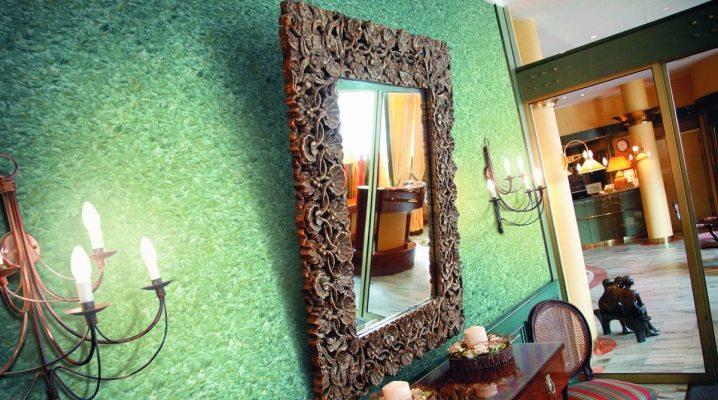
When planning to create an original and beautiful interior in the house, each owner tries to come up with an interesting idea for all available premises. Hallway decoration plays an important role in shaping the overall impression of a home's design. Currently, there are many types of finishes, and liquid wallpaper in the corridor deserves special attention, ideas for the interior with which are varied.
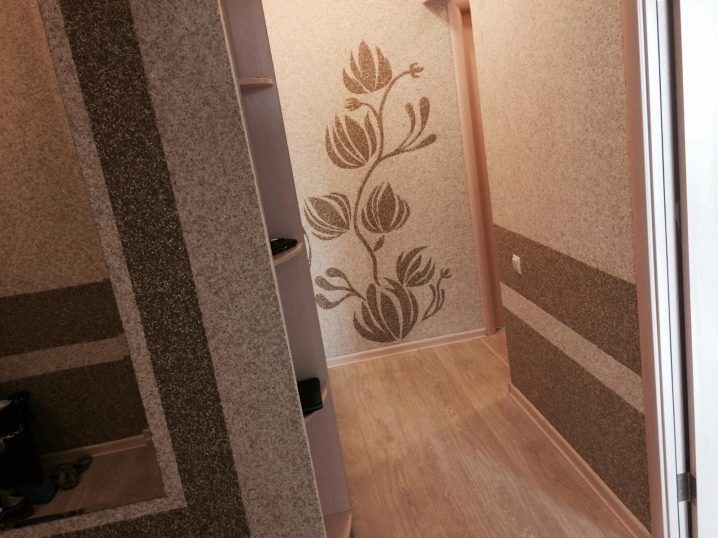
Peculiarities
Liquid wallpaper is a type of wall decoration that successfully combines the properties of ordinary plaster and paper wall coverings.
Liquid differs from the usual roll wall paintings in the method of application, and from plaster - in composition and texture.
Liquid wallpaper is made from cellulose fiber mixed with a special binder. Depending on the design requirements, the mixture may include additional components that determine the color and structure of the wall decor, such as dyes, silk or cotton fibers, mica, shavings, sand and others. Due to the variety of fillers, the color and texture of the liquid mixture can vary in a wide range, which means that the use of such material will be appropriate in any type and style of room.

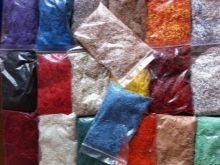

To determine the need to use liquid wallpaper, you should evaluate all the pros and cons of this material:
- Resistant to temperature extremes. This property allows the use of such material not only in home premises, but also in country country houses, which are not required for heating throughout the year.
- The dyes included in the composition are not susceptible to UV rays, therefore, they do not fade under the influence of direct sunlight.
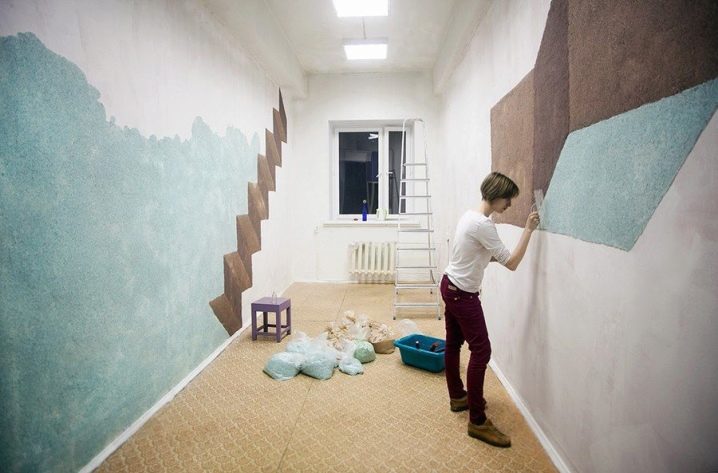
- The decorative mixture smooths out wall defects, fills in minor cracks, depressions and other flaws.
- Lightness and ease of use. Applying the finish will not be difficult; if necessary, cleaning the surface of such material is also quite simple.
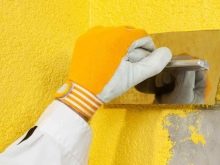
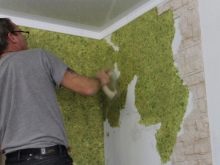
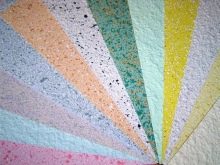
- They help to improve the heat and sound insulation properties of the walls.
- The mixture is formulated with safe, non-allergenic materials.
- Easy to care for. The coating can be easily cleaned of dust and stains.
- The mixture does not absorb and does not allow moisture to pass through, and due to its special composition, it excludes the possibility of mold and mildew.
- The ability to finish any surface, not only walls, but also columns, arches, various niches, due to the elasticity of the material.
- Creation of a beautiful laconic interior. Indoors, this finish looks very original due to its beautiful texture and variety of shades.
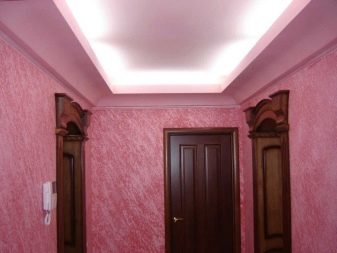
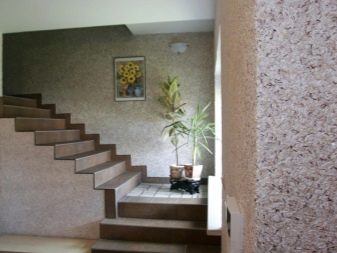
There are practically no drawbacks to liquid wallpaper, but the following should be taken into account when decorating the interior of the corridor:
- Despite the property of not accumulating moisture, this type of wallpaper is afraid of water, therefore, it is not recommended to use them in rooms with high humidity. However, it is this ability that facilitates the process of removing the covering from the walls.
- It is not recommended to wash liquid wallpapers, they should be dry-cleaned with a vacuum cleaner or dry rags. If a stain appears on the surface, you can get rid of it with the help of a liquid mixture, simply by painting over the required area. Therefore, it is better if this wallpaper option remains in stock.
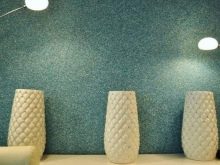
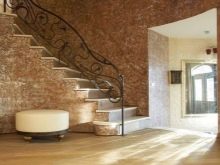

- The cost of liquid wallpaper is much higher than usual.
- This type of wall decor will not be able to hide significant surface defects, therefore, before applying the material, you should carefully inspect the walls and, if necessary, level them.
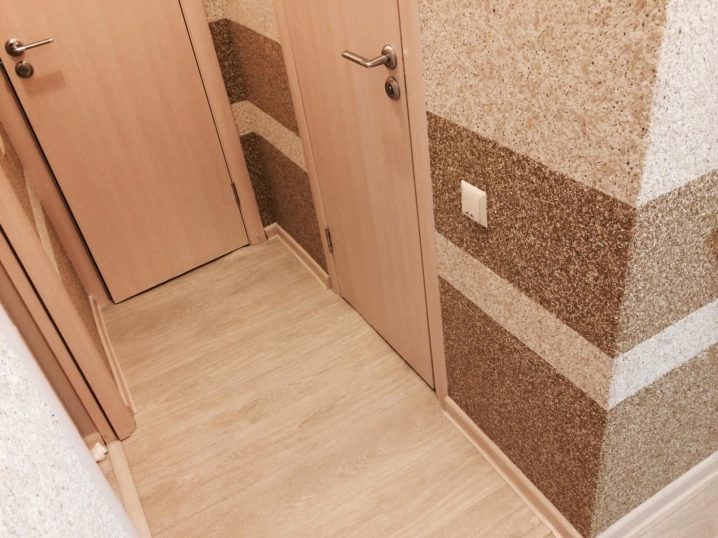
Views
In the decoration of the corridor, you can use all existing types of liquid wallpaper, but it is worth choosing the most priority varieties.
- Cellulosic. They are based on paper. This coating is most susceptible to various dirt and moisture, therefore, finishing with this type of wallpaper will be short-lived, and operation will not bring much pleasure, since such wallpaper needs constant care and monitoring (inspection of the walls for stains and unintentional dirt).
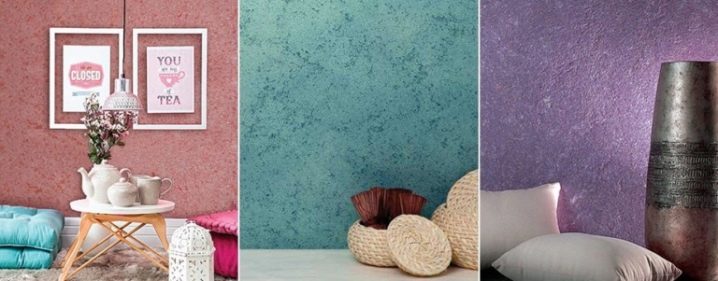
- Silk. In addition to paper, they include fine silky threads. This type is more hardy, therefore not very demanding on possible external influences and adapts well to the conditions created in the room.
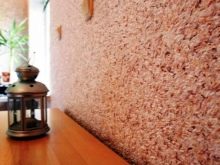
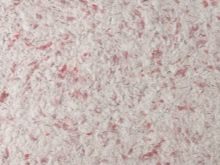
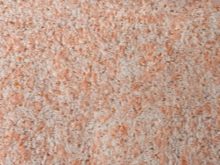
- Textured. Includes rock chips, sand or mica - the most durable and practical material. This type of wallpaper is considered the best option for wall cladding in the corridor, although its price is quite high, not everyone can afford it.
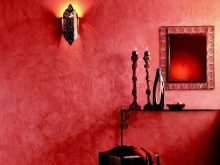

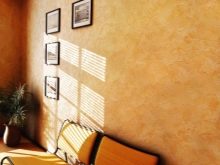
- Combined. They are a homogeneous white mixture that can be combined with various desired ingredients.
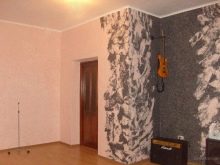
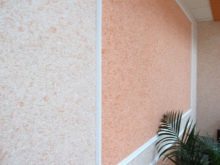
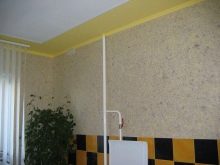
Which one is better to choose?
To decorate a hallway or corridor, it is necessary to select liquid wallpapers that can create a welcoming atmosphere, will combine an attractive design with the characteristics of practicality and durability. The first step is to take into account such a feature as the degree of light penetration.
With insufficient lighting, the use of wallpaper in dark colors for the corridor is extremely undesirable, since such a finish will visually reduce the size of the room.
Problems will not arise in large rooms with sufficient lighting, in this case the choice of colors depends only on the personal preferences of the owners.
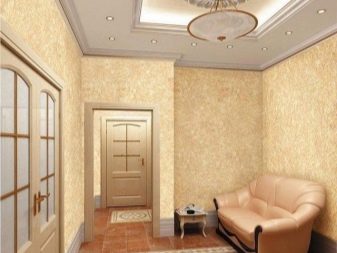

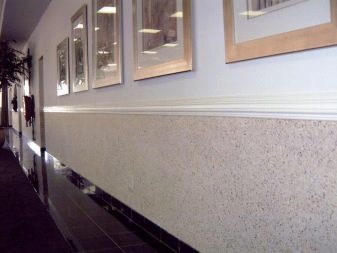
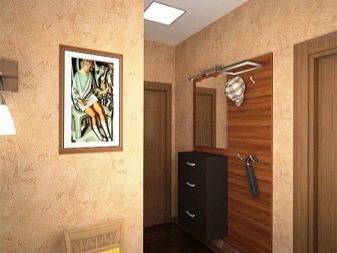
For an apartment with a small corridor, you should not choose too bright and defiant shades, they tend to absorb light. This moment will make the interior of the room intrusive and unpleasant.
For the decoration of the hallway in the "Khrushchev", panels are considered a classic version of wall decoration, it is they who visually correct some of the flaws of a small room.
And if you combine them with liquid and washable wallpaper, you can give the corridor practicality, thanks to which some difficulties in cleaning the surface will come to naught.
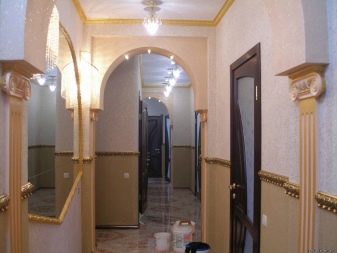
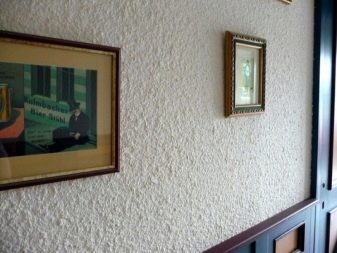
The combination of several shades on the wall will help distract guests from the flooring. At a height of about half a meter from the floor, it is better to use wallpaper in darker tones, and above and to the ceiling - light shades. Such a trick in applying wallpaper will visually increase the height of the room, the perception of lighting will become more intense. The decoration of the corridors also looks original with different pattern options. By imparting a thicker consistency to the mixture, you can create a variety of stucco elements, and this will add luxury and chic to the interior design.
In order to ensure the longest possible life of the wall covering, the surface finished with liquid wallpaper can be covered with an additional layer of varnish, which will protect the new type of decor.
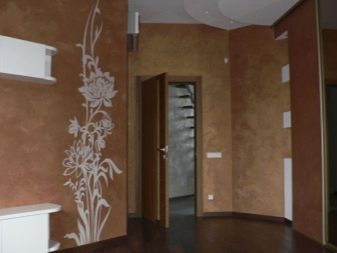

Finishing
It will take some time to prepare liquid wallpaper for application, so preparation should be started already at the stage of priming the walls, when the repair is coming to an end. A dry wallpaper mixture can be prepared from individual ingredients in different packages, and all the ingredients can also be mixed in one package.
In any case, the contents of the bags must be mixed until smooth, so that there are no lumps in it.
When diluting a dry mixture, it is necessary to take only the amount of water specified in the instructions.
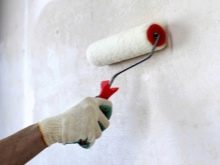
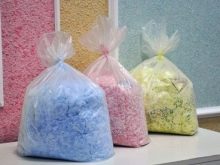
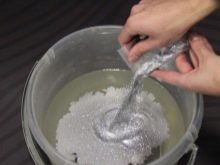
The contents of the bag must be kneaded in full in a separate container.Pour the dry mixture into the water, and not vice versa. To homogenize the mass, the use of drills is not recommended, this process can lead to a change in the structure of the fibers and, accordingly, a violation of the consistency.
You need to mix the composition with your hands, this procedure is absolutely harmless to human skin.
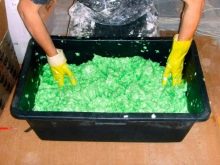

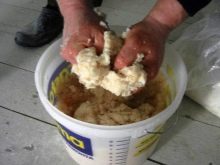
For applying liquid wallpaper, the same tools can be used as for applying plaster. The number of portions required for application to a certain area should be done in one batch, since the compositions of different batches on the same wall may differ slightly. You can calculate the amount of the mixture based on the instructions for use. On average, 1 kg of wallpaper can be distributed over 5-6 sq. m of surface. Remains from mixing on one wall can be used in mixing for another wall.
The prepared mixture under the correct storage conditions, without access to air, can stand for several weeks.
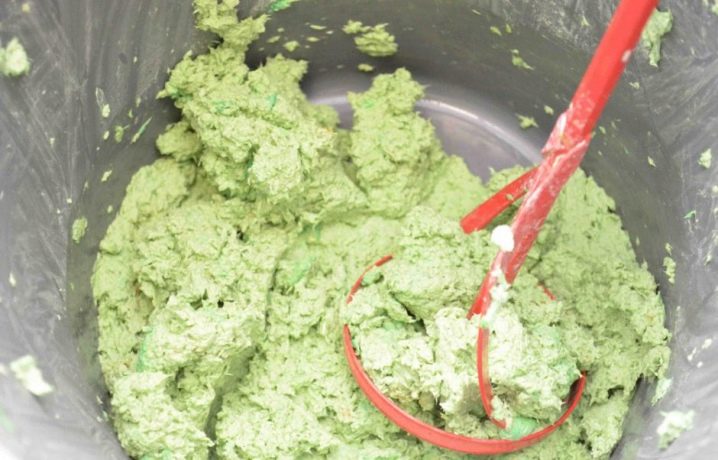
Using a spatula, the prepared material is grated and applied to the surface in small portions. The composition is ground up to 2-3 mm thick, it is advisable not to take your hand off the surface to be treated in order to avoid the formation of seams. By adjusting the pressure on the tool, the composition is applied in this way until an area of approximately 1 square meter is filled. m, after that the finished area is leveled with a grater dipped in water. After finishing the entire wall, you need to walk again with a wet float on the surface.
The drying process lasts about 2-3 days, depending on the temperature regime.
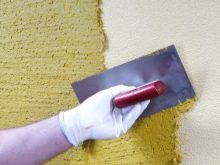
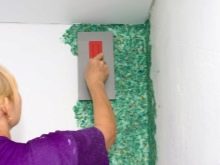
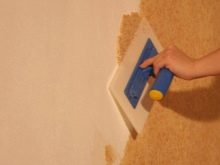
Mixes of different colors are used for drawing pictures. The sketch must be applied to the surface of the wall, and then the desired compositions should be applied in several stages at intervals of a day.
With strict adherence to the application technology and care requirements for this type of finish, the coating will last for a long period of time, pleasing the eye with its beautiful and original look.
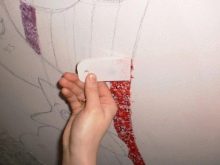

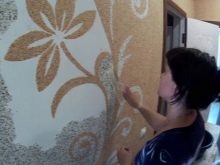
Interior options
In the interior design of the hallway, the choice of the color palette will play a huge role. Combinations of white colors and different shades of yellow will add brightness and light to the space.
Monochrome wallpaper in cream colors will favorably emphasize the beauty of furniture, as well as various decorative elements. Wallpaper in various shades of blue will add freshness to the room. The combination of red accents and gray elements will help to visually correct the layout of the hallway.
Purple or brown shades will bring originality and mystery to the interior, light furniture looks especially interesting against the background of these colors.
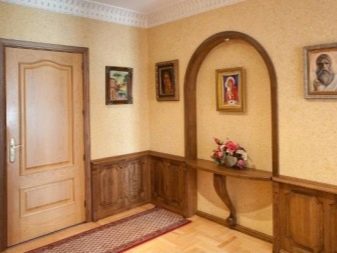
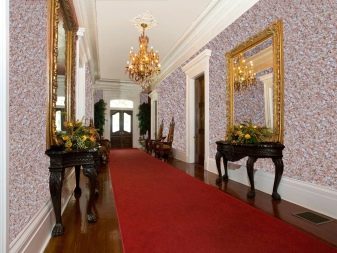

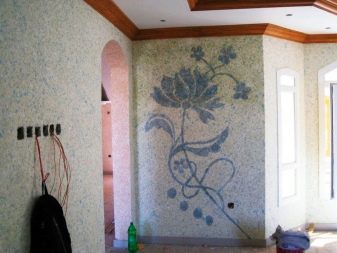
Finishing with liquid wallpaper is textured, therefore, it is not desirable to use a large number of decorative elements in small hallways, these items can oversaturate and burden the interior. The main purpose of the hallway is to perform practical functions. With the help of various options for combining wallpaper, experts propose to advantageously zone the room, achieving the desired effect.
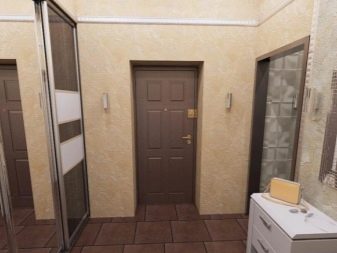

For information on how to properly apply liquid wallpaper to the wall, see the next video.













The comment was sent successfully.